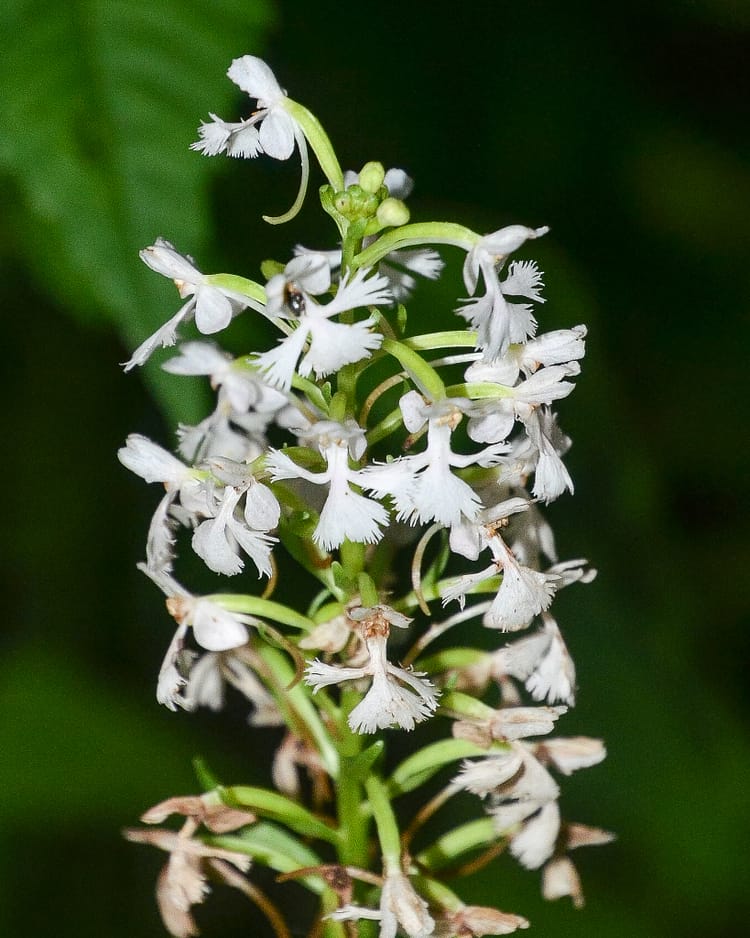Just before the last week of June, we squeezed in 11.7 miles in three separate hikes. My goal was to find more native orchids and wildflowers before leaving for the Pacific Northwest to visit our daughter. The Round-Leaf Orchid (Platanthera orbiculata) is one of my favorites, and a tricky one to find, as the understory quickly hides its fleshy, orb-like leaves. The Purple-Fringed Orchid loves mountain bogs and can be a challenge to photograph if the slightest breeze is present.
Our first two hikes were on the Appalachian Trail, near the TN/NC border. The first day, we headed north. The next day, we hiked south. Before beginning our hike, we slogged about in the boggy area, finding the Small Purple- Fringed Orchid. What was really amazing was that the white form of this orchid was also present; such a gift! These orchids were a bit past their prime, but still gorgeous. Our time, as well as daylight, was limited. Such is the price for after-work, weekday hikes.
The Forest Service highlighted Small Purple-Fringed Orchid as a plant of the week: https://www.fs.fed.us/wildflowers/plant-of-the-week/Platanthera-psycodes.shtml
Bog slog…
A few weeks ago, my friend Joan and I found Small Purple Fringed Orchid, which were in their prime: https://hikescape.org/a-bounty-of-native-orchids-and-wildflowers-big-ivy-in-june/


Heading north on the AT:
The Round-Leaf orchid is often found with indicator species, such as Clinton’s lily (Clintonia umbellata) and Indian Cucumber root, a member of the lily family. Like many other native orchids, the Round-Leaf is dependent upon fungi in the soil and should never be disturbed. We also found many leaves that did not have blooms.

The following day’s trip netted other wildflower sightings. It was a beautiful afternoon, but I was feeling fuzzy-headed after medicating my summer cold. We first spent some time in a meadow, surrounded by pollinators engaged in their frenzied activities. The large heads of yarrow had begun to tower above the grass and other plants.
Whorled loosestrife was catching the final rays of the sunny afternoon.

Yarrow, Achilea millefolium 
Whorled Loosestrife, Lysmachia quadrifolia 
Milkweed was prevalent, thank goodness, as this provides a critical food source for Monarch butterflies. https://www.fs.fed.us/wildflowers/pollinators/Plant_Strategies/index.shtml
Even the leaves were competing for attention, showing off their complex vascular structure for photosynthesis.

Turks’s Cap lilies were abundant, but not yet in bloom. The one on the left may have as many as eight flowers!

Round-Leaf Orchids: location, location, location…
Our third, and final hike, was in the Appalachian Ranger district near the Craggy Mountains, a favorite spot for the Round-Leaf and other native orchids. This trail is marked by a series of switchbacks, and boasts a full spectrum of wildflowers. It was a windy day, but there were some sheltered spots as we headed up the trail. We began our hike in the early morning, with no concerns about twilight decreasing our visibility.

Finding the Round-Leaf orchid again was such a joy! It is so distinctive, with the shiny, basal leaves, and unusual greenish-white spurred flowers dancing about the stalk.

Rotting logs provide a good habitat for these orchids.

Columbine and other beauties…
We continued up the switchbacks, and off the trail, I spotted a pinkish-orange flower, hiding among the underbrush. Columbine- what good fortune! I carefully moved through the growth to get some photos, and continued up the trail. Over the next few miles, we encountered four or five different stands of Columbines.
As I was photographing the final bunch, some other hikers came along. They breezed right by and it appeared they didn’t notice the Columbine that was right on the trail!


Columbine, Aquilegia canadensis 
Columbine, Aquilegia canadensis 
Columbine, Aquilegia canadensis
Another wildflower found in this woodland cathedral is Fire Pink. It is such an eye catcher with its bright red flowers!

Spiderwort is another faithful companion in the Southern Appalachians. Their bloom time spans from mid-spring to late summer. The sticky filaments around the stamens are perfect for pollinators.

The brilliant yellow flowers of the Sundrops are a sunny, welcoming presence. It seems as though there are very few habitats where they don’t thrive.

Galax can be found all year round, with its shiny, frilly leaves that take on a burnished color when touched by the winter sunshine. This is an early glimpse of the Galax in bloom; this was an image from nearly two weeks ago, and just today I saw Galax in another area that had not yet begun to bloom.

I am behind in cataloging my journeys. However, the truly important thing is to immerse myself in the woods, where there is no schedule but the rhythm of nature. Happy Trails- I hope you are getting out there to do what you love!


